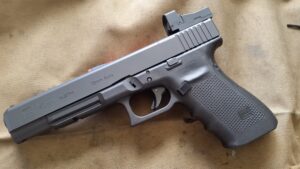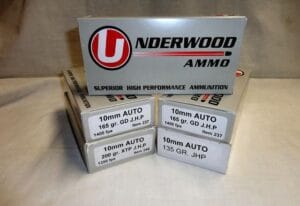You’ve heard the phrase: “A Jack of All Trades, Master of None.” However, in the world of firearms, versatility – the quality of being useful for or easily adapted to various tasks, styles, and fields of endeavor – often means that a single weapon can be a Master for All Situations.
It may not be a function of caliber, nor the capacity of the magazine, or the optic on top. It is a function of ammunition. And there are two weapons that stand head and shoulders above most others in this respect – the shotgun and the 10mm pistol.
The ubiquitous shotgun; it has been around for over 400 years and is often called a scattergun, or historically as a fowling piece. Calibers have been many; for this discussion we will stick with the always-popular 12 gauge and what a variety of ammunition we have!
Birdshot is probably the most common type of 12-gauge shotgun load, comes in at least 12 sizes, and allows hunters to target small to medium game (or skeet and trap shooters to hit clay “birds.”) For birdshot, the larger the number, the smaller the pellet (size 8 has more, but smaller diameters of pellets than a size 6, for example.)
But wait! Many 12 gauge shotguns now come with the ability to fire three chamber sizes – 2.75-inch, 3-inch and 3.5-inch. The longer the size, the more pellets there are inside, plus the velocity is often higher which extends the range a bit. Then there is BB shot that comes in at least 3 sizes, used for larger birds like ducks and geese.
Leaving the search for aerial targets and going to the ground gets us into buckshot and there are five rounds in that (#4 buck, #1 buck, 0 buck, 00 buck and 000 buck.) For example, #00 buckshot throws eight or nine balls (some magnum loads contain 12-15 balls!), #1 buckshot holds 16 and #4 buckshot has 24 to 27 balls. Then there are the “tweeners” like T-shot that I put in the category of hunting large waterfowl like geese.
Finally are the slugs that are used for deer, and really any other large game; some hunting guides even opine that a 12-gauge slug is the best antidote for an attacking bear. Almost every 12 gauge round can kill a man; there are tragic hunting accidents every year involving even very small size birdshot rounds. For the intentional dispatching of an armed criminal trying to kill you, buckshot is probably the best way to go. The versatility comes in when analyzing the environment of the shot. Inside the home or outside? Is the attacker on foot on in a motor vehicle? Behind a barrier? What is the expected distance between you and your would-be killer? More than one assailant? There will be an optimum-size shotgun round for every situation. That is what gives it the ultimate in versatility.
But you know that already. The second weapon with immense versatility is the 10mm pistol – which you may not be familiar with – and it also centers on the large variety of ammunition available for it. MidwayUSA lists sixty-six 10mm rounds (unfortunately most have to be back-ordered, but that’s a different issue.) By my count, 10mm rounds range in weight from 100 grains to 220 grains, which is close to a .380 auto round weight on the small end, to a .44 Magnum on the large end.
10mm rounds come in various bullet shapes, each with a different purpose in mind: hard-cast-flat-nose and lead-round-nose for large game hunting; jacketed-hollow-point, full-metal-jacket, “fluted”; bonded-jacketed-hollow-point; and fragmenting-hollow-point; full-metal-jacket-flat-nose.
But it is velocity that provides even more versatility. Muzzle velocities range from about 1030 feet-per-second to 1875 feet-per-second. There is one type of round, an RBCD Performance Plus out of San Antonio, that advertises a 10mm 77 grain total-fragmenting-soft-point that comes out of the muzzle at 2420 feet-per-second, but I can’t find any for sale, which might be a good thing.
What versatility does velocity provide you? Well, in potentially crowded urban areas, in a self-defense situation where you don’t want your bullet going through your erstwhile killer – and subsequently killing an innocent person, you can do your homework and pick the round type and velocity to ensure it doesn’t “over-penetrate.” In rural areas, you can use heavier and faster rounds, because you are not concerned with bystanders, but are concerned about dangerous four-legged animals, as well as two-legged ones.
I wish I had figured out the versatility of a 10mm years ago. I have been firing a 12-gauge shotgun for four decades and a 10mm (with 18 different ammunition types and speeds) for just four weeks. But who says an old dog can’t learn new tricks?

